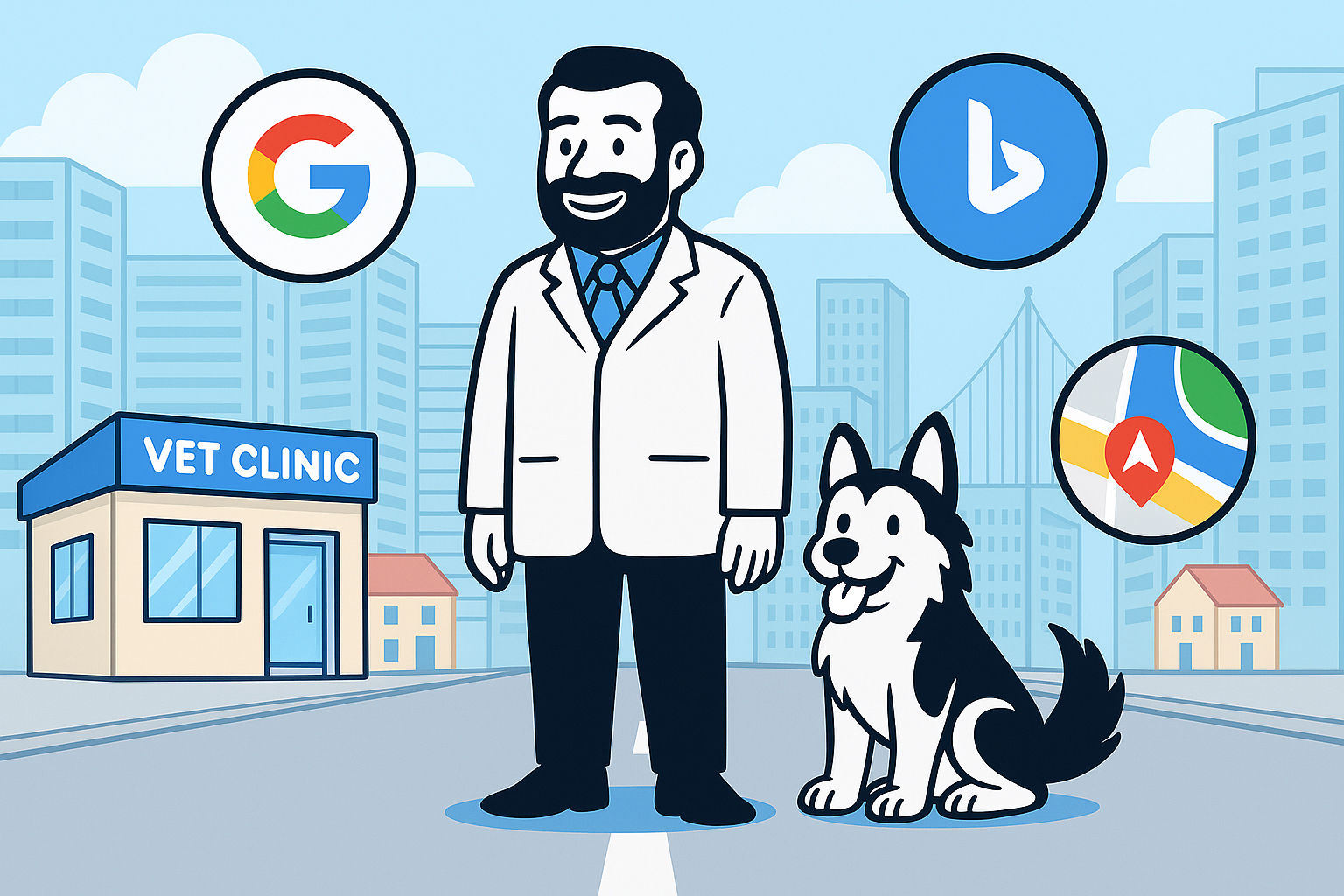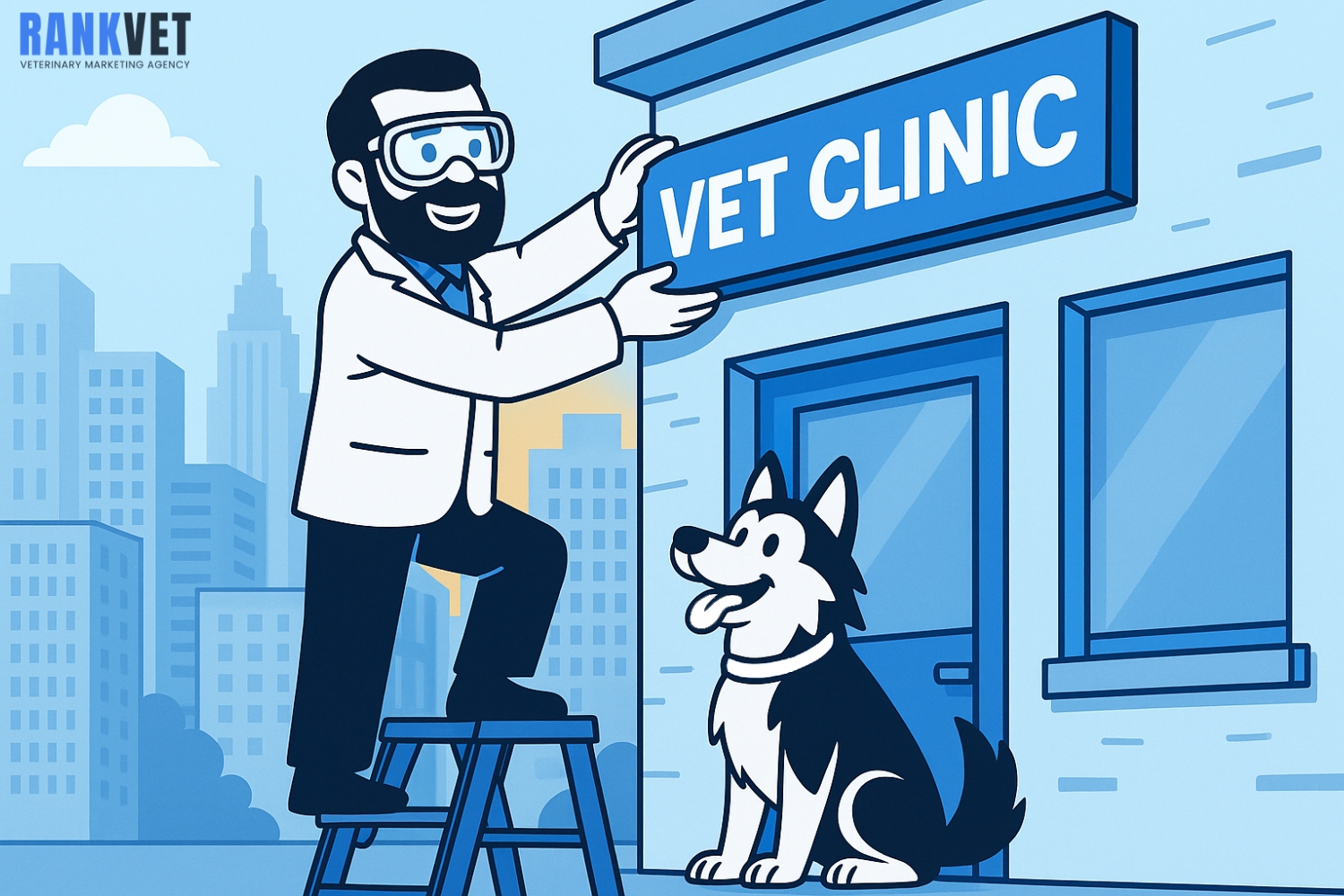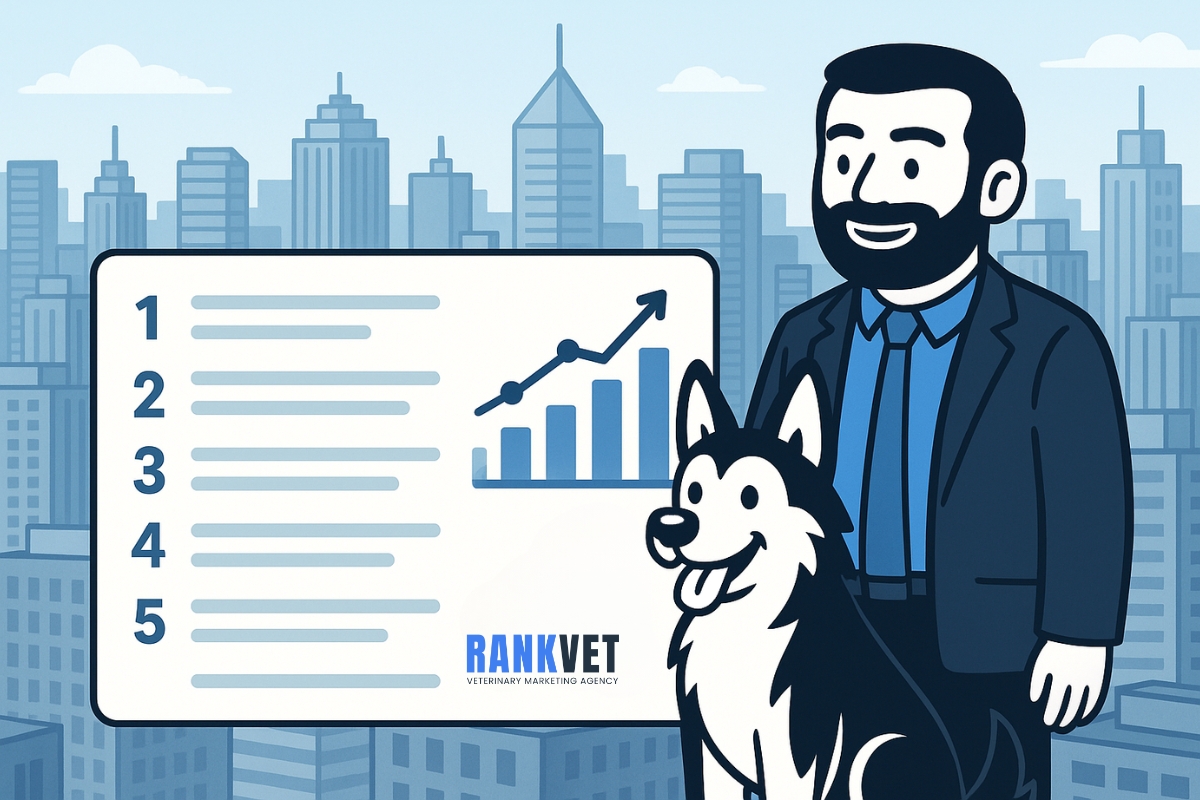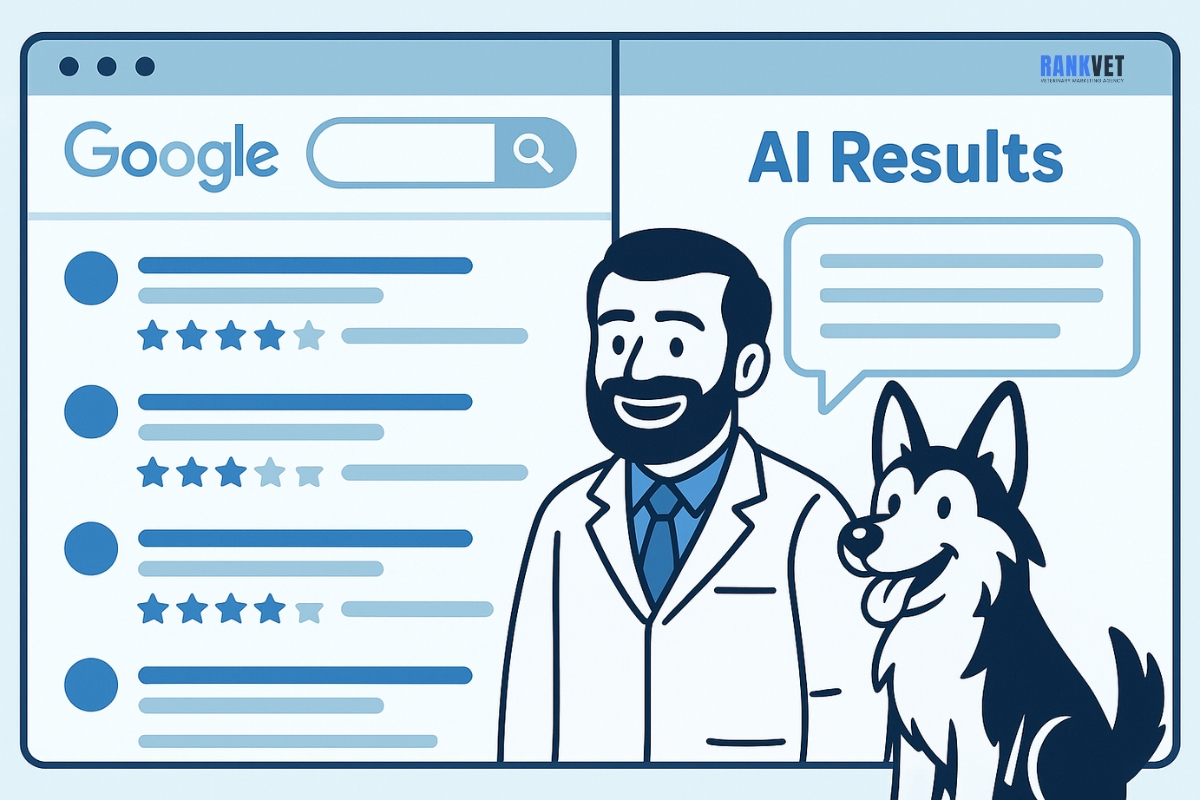More than 46 % of all Google searches carry local intent, and on mobile that percentage climbs even higher – proof that “near me” moments are now the decisive touchpoints in a pet owner’s care journey. Pair that with survey data showing 72 % of consumers who perform a local search visit a business within five miles, and you can see why the map pack has become the new waiting room door. For veterinary practices, the stakes are even higher: Promodo’s industry snapshot found that 93 % of pet owners rely on Google to locate their nearest clinic or hospital. Visibility equals appointments, and appointments equal healthier pets and stronger revenue.
Local SEO isn’t a magic trick; it’s a disciplined process of signaling relevance, proximity, and trust to Google’s algorithm. That process starts with rock-solid business data (NAP consistency), extends through on-page optimization and local link equity, and is amplified by authentic reviews. Google Business Profile (GBP) is your anchor, but ranking factors such as keywords in page titles, inbound links, and behavioral signals like click-through rate all play supporting roles. Below, you’ll find a step-by-step playbook fine-tuned for veterinary clinics – complete with real-world examples, current stats, and practical tips you can implement this week.
Related Service: Veterinary SEO
What Exactly Is Local SEO – and Why Do Vets Need It?
Local SEO is the art and science of making sure your clinic appears when nearby pet owners search for services you provide – think “emergency vet Seattle” or “rabbit spay Birmingham.” At its core, Google weighs three pillars: proximity (how close the searcher is), relevance (how well your content matches the query), and prominence (your overall reputation online). Mastering these pillars puts you in front of pet parents at the precise decision point, often on the same device they’ll use to call and book. Studies show 50 % of local mobile searches lead to a physical visit within 24 hours; in healthcare niches that window is even shorter. Translation: rank locally and you don’t just earn clicks – you earn trust and foot traffic.
Veterinary medicine carries an emotional weight that other local verticals lack. Owners aren’t comparison-shopping for a basic haircut; they’re entrusting a family member to you. BrightLocal’s 2024 survey confirms that 87 % of consumers “always” or “regularly” read reviews for local healthcare businesses before committing. In the vet world, RepuGen’s dataset shows 83 % of pet owners demand at least a four-star average before calling a clinic. A rigorous local-SEO strategy ensures that when those emotionally charged searches happen, your clinic appears with sterling social proof and an easy booking path.
Claiming & Optimizing Your Google Business Profile (GBP)
Google Business Profile has overtaken your homepage as the first impression for most prospects; Uberall’s 2024 ranking-factor study ranks GBP signals #1 for map-pack visibility. Verification is just the starting gate – fully optimized listings generate up to 70 % more direction requests and calls than bare-bones profiles. Fill every field with the same diligence you’d apply to a medical chart: accurate NAP, concise service descriptions, rich media, and timely updates. Google’s own support docs emphasize completeness and freshness as direct ranking inputs, and recent back-end leaks confirm the platform tracks image uploads, Q&A activity, and post frequency as quality signals.
Think of GBP posts as mini-blog entries that age quickly; weekly cadence keeps your profile “alive” in Google’s eyes. For vets, creative angles include adoption-day shout-outs, seasonal parasite reminders, or behind-the-scenes surgery snapshots (HIPAA-style privacy observed, of course). Each post extends your keyword footprint and invites engagement – signals that nudge your ranking forward. Remember, category choice is foundational: “Veterinarian” must be primary, while secondary categories (e.g., “Animal Hospital,” “Emergency Vet”) should map to actual services you provide to avoid suspension.
Core Checklist
- Verify & correct NAP (Name, Address, Phone).
- Select precise categories – primary: Veterinarian; secondary only if you truly offer the service.
- Complete every field (hours, services, appointment URL, etc.).
- Add fresh photos/videos weekly to signal activity.
- Post weekly: a “Pet-of-the-Week” update or promo keeps engagement high.
Pro tip: Don’t keyword-stuff your clinic name. Google can suspend listings that game the system.
Building a Local Keyword Strategy That Attracts Pet Owners
Keyword research isn’t about chasing vanity traffic; it’s about aligning content with the precise language pet owners use when their need is urgent. Tools like Google Autocomplete, “People Also Ask,” and local SERP analysis reveal long-tail gems such as “puppy vaccination schedule Toronto” or “exotic reptile vet Denver.” These phrases often show purchase intent but face less competition than broad terms like “veterinary clinic.”
Balance volume and specificity. Aim for a hub-and-spoke structure: core service pages optimized for high-volume “vet + city” terms, and supporting blog posts answering “how much does cat dental cleaning cost?” for semantic breadth. Use schema markup (VeterinaryCare or AnimalShelter) to reinforce topical relevance; Google’s Knowledge Graph increasingly relies on structured data to connect entities, so explicit markup acts as a clarity beacon. Finally, cross-link pages with keyword-rich anchor text to distribute authority.
Find “Service + Location” Gems
Long-tail, location-tethered keywords convert at higher rates because they mirror conversational search. 88 % of local mobile searches either call or visit the business within 24 hours. Use the “near me” permutation sparingly in copy (Google gets the context), but leverage it in title tags for pages dedicated to urgent care, spay/neuter, or exotic-pet services. Don’t overlook airport codes (“vet near SEA”) or well-known landmarks; these micro-geographic cues help your pages win hyper-local micro-queries with minimal extra effort.
Second, monitor Google Trends seasonality. “Tick prevention” searches spike in spring, “fireworks anxiety dog” in early July. Craft landing pages or GBP posts around these peaks to ride query waves. Support each focus term with FAQ schema to capture people-also-ask real estate and improve zero-click visibility.
Place Keywords Where They Matter
Search-engine bots still rely on classic HTML signals. Ensure every service page has a unique, ≤60-character title incorporating both service and city (e.g., “Cat Vaccinations in Austin | Purrfect Health Vet”). Sprinkle the exact phrase in the H1 and opening 100 words, then layer synonyms throughout. RankVet’s heat-map of winning local pages shows a clear density around headlines and first paragraph. Alt text on images can include keyword + species cues (“Golden retriever dental cleaning, Seattle clinic”) to drive visibility in image search.
Beyond HTML, mirror those keywords in your GBP services, Q&A replies, and review responses – this multi-channel reinforcement strengthens entity understanding. Do not, however, shoehorn keywords into your clinic’s GBP name; Google’s November 2024 spam update harshly penalizes that tactic.
Go Hyper-Local
Neighborhood modifiers (“Capitol Hill vet”), transit corridors (“clinic near I-35”), or colloquial nicknames (“NoDa Charlotte”) help you rank for underserved queries. RankVet’s 2025 statistics reveal that listings using neighborhood terms in copy secured up to 23 % higher click-through rates in dense metro areas. Embed these micro-modifiers in meta descriptions, H2s, and link anchor text.
Offline, reinforce hyper-local authority by sponsoring pet-friendly events or hosting low-cost vaccination clinics; local press mentions often include do-follow links that pass credibility. Geo-tag uploaded images (e.g., exterior shots) so EXIF data confirms your coordinates – small signal, big cumulative lift when paired with other local cues.
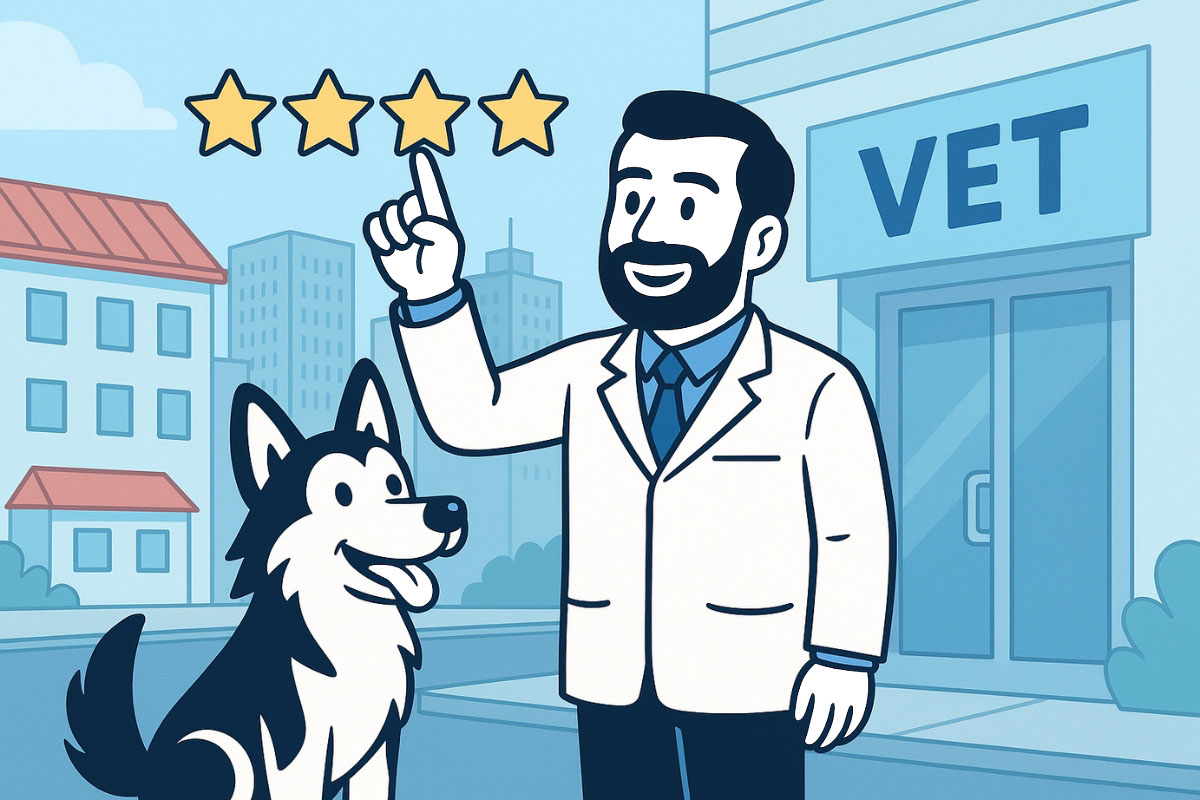
Managing Reviews to Turn Happy Clients into Ranking Rocket Fuel
Reviews influence two realms: consumer psychology and Google’s “prominence” ranking factor. RankVet’s 2025 analysis states that review quantity, velocity, and keyword usage now rival proximity in importance for competitive metros. From the client’s perspective, RankVet reports that positive sentiment and star rating outweigh even cost considerations when choosing a vet.
Engineer a feedback flywheel: request reviews at peak happiness (post-visit treat bag in hand), streamline the process with a direct link, and respond promptly. Data shows that 57 % of consumers will change their perception of a business based on review replies. Consistent, genuine responses also give you a micro-opportunity to reinforce service keywords and showcase empathy – traits pet owners value highly.
Ask at Peak Emotion
Timing trumps volume. The exam-room hand-off, when relief or joy is highest, yields your best response rates. A QR code on a “Happy Visit” card or an SMS with a pre-filled Google review link reduces friction. RankVet notes that personalized photo follow-ups (picture of Fluffy post-groom) can boost review completion by 35 %. Always secure verbal consent before snapping pics to safeguard privacy.
Automate (but Personalize)
Use practice-management software integrations to trigger automated review requests 4–6 hours after check-out. Personalize tokens – pet’s name, procedure, vet name – to avoid the “robot” feel and drive completion. Automation ensures consistency; personalization protects authenticity, satisfying Google’s spam-detection algorithms introduced in 2024.
Reply to Every Review
Positive feedback deserves gratitude and subtle keyword reinforcement (“Thank you for trusting us with Bella’s dental cleaning…”). For negatives, speed and empathy matter: respond within 24 hours, invite offline resolution, and document steps taken. A follow-up asking the client to update the rating after resolution often turns a detractor into an advocate.
Showcase Reviews On-Site
Widgets pulling live Google reviews keep your website content fresh – an indirect ranking factor—and build trust early in the funnel. Choose a plugin that marks up reviews with AggregateRating schema so your star average can appear in organic snippets, improving click-through by up to 35 % per Schema.org’s case studies.
Beyond the Basics: Local Links, Citations & Behavioral Signals
Once GBP, on-page copy, and reviews are dialed in, elevate your authority through consistent citations and meaningful local backlinks. Whitespark’s most recent survey lists domain authority of inbound links as a top-five local-pack factor. Focus on quality over quantity: one link from a city newspaper or state veterinary association can outweigh dozens of generic directories.
Behavioral signals – click-through rate, dwell time, bounce rate – also influence local rankings indirectly. Google’s leaked documents confirm it monitors “interaction data” to validate listing relevance. Fast, mobile-first design, clear calls to action, and sticky content (e.g., interactive symptom checkers) improve these engagement metrics and, by extension, your map-pack staying power.
Must-Have Citations
Citations are table stakes: state vet directory, AVMA’s MyVeterinarian, Yelp, Apple Maps, Bing Places, and specialty platforms like VetRatingz. NAP must be identical – no rogue commas or suite numbers – which means adopting a canonical format and sticking to it across every listing. Consistency prevents algorithmic confusion and manual user mistrust.
Earn Locally Relevant Backlinks
Traditional PR still works: sponsor a “Dog Jog 5k” or partner with shelters during Adopt-a-Pet month. These activities attract local press citations and social shares that build both brand affinity and link equity. Even small-scale collaborations – co-authoring a flea-and-tick guide with a groomer – can yield contextual links that Google values more than global, generic mentions.
Boost User-Engagement Signals
Page-speed matters: 53 % of mobile sessions depart if load time exceeds three seconds, according to Google research. Compress images, defer unused JavaScript, and enable server-level caching. Layer structured data (FAQPage, VideoObject) to occupy more SERP real estate and reduce pogo-sticking. Embed one-click “Book Now” buttons so conversions happen before attention drifts.
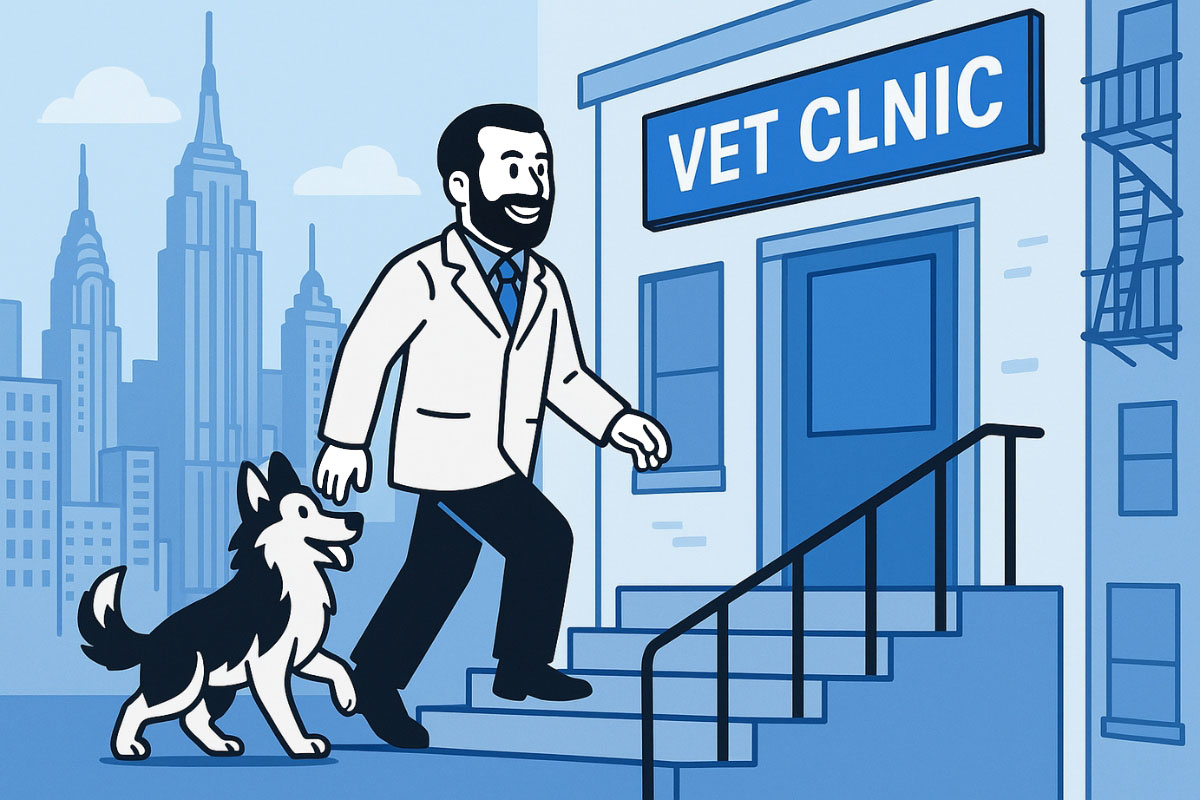
Ready to Climb Those Local Rankings with RankVet?
Local SEO is an iterative discipline, not a one-off project. Algorithms evolve, competitors pivot, and pet owners’ expectations rise – especially among millennials who now look for sleek clinics with app-based scheduling and coffee-bar vibes. By treating optimization as an ongoing habit – updating GBP weekly, harvesting fresh reviews, adding seasonal content – you adapt faster than competitors and safeguard hard-earned positions.
RankVet’s vet-led approach adds an insider’s credibility to proven digital tactics. We speak both languages: the clinical nuance pet owners respect and the technical SEO depth Google rewards. Schedule a free consultation or request a website audit today, and let’s make your clinic the obvious choice in every “near me” moment.


